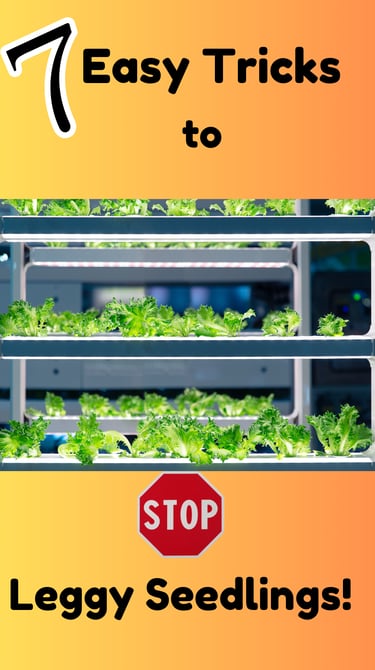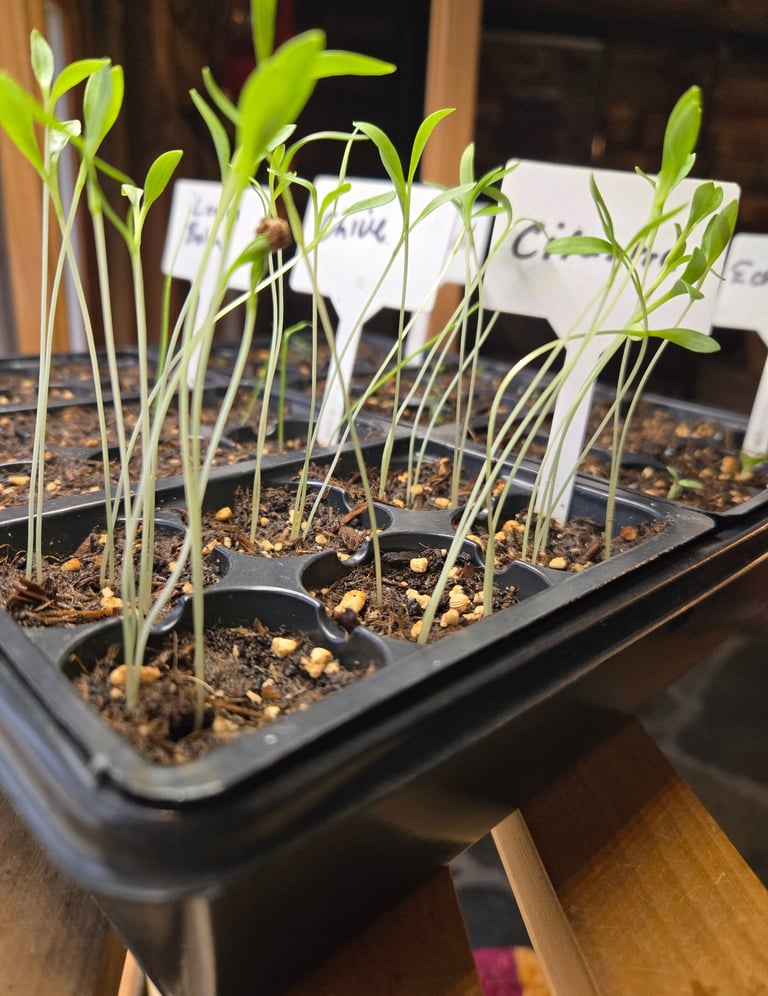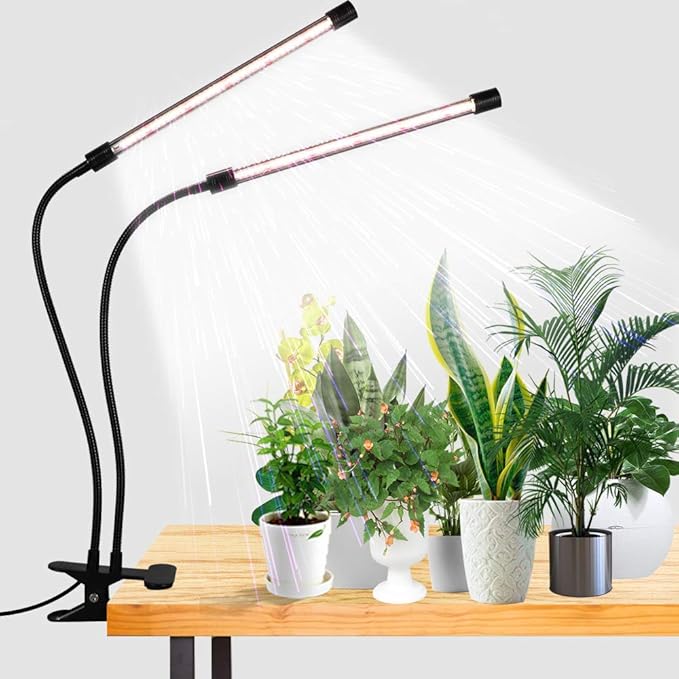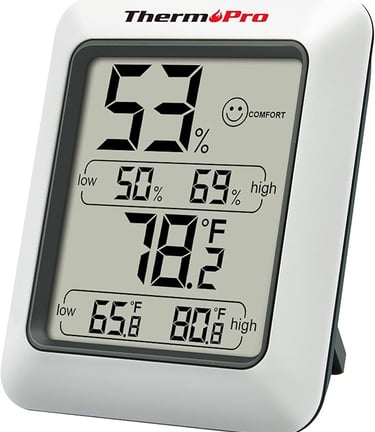7 Easy Tricks to STOP Leggy Seedlings!
Discover 7 foolproof tips on how to prevent leggy seedlings under grow lights and grow sturdy, healthy plants every time.
GARDENING


Hey there, fellow gardeners! You know the feeling—you've lovingly planted your seeds, carefully watered them, and eagerly waited for them to sprout. But instead of strong, sturdy seedlings, you've got tall, spindly little plants flopping around as if they're auditioning for a garden ballet. Yep, you've got "leggy seedlings."
But don't worry! Leggy seedlings happen to everyone, especially if you're just getting started with indoor gardening under grow lights. Today, we'll talk about exactly why this happens and, most importantly, how you can prevent it from occurring. By the end of this friendly chat, you'll know exactly what to do to make sure your seedlings are healthy, sturdy, and ready to thrive in your garden.
Let's dig in! (Pun totally intended.)
"Leggy" seedlings are exactly what they sound like—long, thin seedlings that seem to stretch desperately upwards. These tiny plants are basically begging for more light. They grow tall and thin because they're reaching towards whatever light they can find.
Here's why that's a problem:
Weak stems: The thin, elongated stems are fragile and often can't support the weight of the plant.
Poor root systems: Energy is going into upward growth, leaving the roots undeveloped.
Lower survival rate: Leggy seedlings struggle more when transplanted outdoors, often breaking or wilting at the first gust of wind or rain.
Clearly, we don't want this for our seedlings. But what's causing it?
Why Do Seedlings Become Leggy Under Grow Lights?
Simply put, seedlings become leggy when they don't get enough intense, direct light. When plants grow outdoors, they're naturally drawn to the sun. But indoors, under grow lights, your seedlings might not be getting the intensity or duration of light they really need.
Common reasons seedlings become leggy include:
Lights too far away: If your grow lights are positioned too far from your seedlings, plants stretch upward, desperately reaching for the brighter spots.
Incorrect type of grow lights: Not all grow lights are created equal. The wrong kind of bulb might not provide the right spectrum or intensity.
Insufficient light exposure: Seedlings need a solid 12-16 hours of quality light every day. Less exposure can result in weak and leggy growth.
But don’t fret—let’s go step-by-step through how to correct these issues and grow strong seedlings you'll be proud of.
1. Position Your Grow Lights Correctly (Closer is Usually Better!)
If there’s one piece of advice you take from our chat today, let it be this: Keep your grow lights close to your seedlings. A common beginner mistake is placing lights too far away.
Here's a good rule of thumb for distance:
Fluorescent lights: Keep them about 2-4 inches above your seedlings.
LED lights: Usually placed about 12-18 inches above seedlings, depending on their intensity.
Adjust as they grow: Raise your lights gradually as your seedlings get taller.
How do you know if your seedlings are happy? Well, happy seedlings grow steadily upward but not too quickly. If they start looking stretched again, lower your lights a little bit.
2. Choose the Right Type of Grow Lights
Your kitchen window may be great for herbs, but when you’re growing seedlings indoors, especially in the late winter and early spring, artificial grow lights really are essential.
Here are the main types:
Fluorescent Grow Lights (T5 bulbs): These are affordable, easy to find, and provide a gentle, even spread of light ideal for seed starting.
LED Grow Lights: These are powerful, energy-efficient, and increasingly affordable. Look specifically for full-spectrum LED grow lights for best results.
Avoid incandescent bulbs. They produce more heat than useful light and can even damage your plants. Remember, it's about quality, not just brightness!
3. Give Your Seedlings Plenty of Light Time
Your seedlings are little babies—they need lots of light to grow strong. Aim to provide them with around 12 to 16 hours of quality grow-light exposure each day. A simple plug-in timer can make this incredibly easy. Set it, forget it, and your seedlings will reward you with healthy growth.
Here’s an easy lighting schedule you can follow:
Lights On: 6:00 am
Lights Off: 9:00 pm
This gives your seedlings about 15 hours of solid grow light exposure each day. They get a good rest at night, just like we all need!
4. Keep the Temperature in Check
Did you know seedlings stretch more when they're too warm? It's true! If your seedlings feel like they’re in a tropical sauna, they’ll shoot upwards fast, becoming leggy. The ideal room temperature for seedlings is usually around 60-75°F (16-24°C).
5. Simulate Nature with Airflow and Movement
Have you ever noticed how seedlings outdoors tend to be sturdier? That’s because they have to stand up to wind, rain, and other environmental stresses. To simulate this indoors, gently brush your hand over your seedlings a few times each day or run a gentle oscillating fan nearby.
This movement encourages stronger stem growth and reduces legginess by signaling your seedlings to toughen up. Think of it as a little "seedling gym" workout!
6. Thin Your Seedlings Regularly
Crowded seedlings compete for limited light. It can be hard, but trust me—you have to thin out extra seedlings, leaving the healthiest ones to grow strong. Pinch or snip excess seedlings at soil level to prevent disturbing the roots of the seedlings you keep.
7. Give Your Seedlings a Boost With Reflective Surfaces
Reflective materials placed around your seedlings can bounce extra light back onto your plants, giving them a double dose of brightness. You don’t have to get fancy—simple aluminum foil, white cardboard, or reflective mylar sheets positioned around your seedlings can really boost their growth and strength.
What if My Seedlings are Already Leggy?
Don't panic! You can often salvage leggy seedlings, especially tomatoes, peppers, or herbs. Here's how:
Re-pot deeper: Carefully transplant the seedlings into slightly deeper pots, burying the elongated stems up to the first set of true leaves. Roots will develop along buried stems, providing extra stability.
Increase lighting immediately: Move your grow lights closer right away to prevent further stretching.
Though this strategy doesn't always fix severely leggy seedlings, it certainly gives many plants a fighting chance.
Quick Recap: Your No-Fail Seedling Checklist
Let's quickly recap what we've talked about. To prevent leggy seedlings under grow lights, always remember to:
Keep grow lights close to your plants and adjust regularly.
Choose the right lights: fluorescent T5 bulbs or full-spectrum LEDs.
Provide 12-16 hours of light daily with a timer.
Maintain cooler temperatures around 60-75°F.
Add gentle airflow for stronger seedlings.
Thin overcrowded seedlings.
Use reflective surfaces for extra brightness.
You're Ready for Seedling Success!
So there you have it—no more leggy seedlings, just strong, beautiful baby plants ready for your garden. Don't feel discouraged if you had leggy seedlings before—we've all been there!
Gardening is always about learning and experimenting. Even experienced gardeners occasionally get leggy seedlings. The difference is now you know exactly what to do.
Feel free to share your successes (and even your struggles!) with us here at Rustic Roots Homestead. Gardening is more fun when we share our journeys together.
Happy growing, —here's to healthy, sturdy seedlings, thriving gardens, and endless harvests. You’ve got this! 🌱✨
How Do I Prevent Leggy Seedlings Under Grow Lights?


First Things First: What Exactly Are Leggy Seedlings?






It's also helpful to note that seedlings will grow more compactly if you maintain a slightly cooler temperature once they have sprouted. Keep a thermometer handy to easily check your growing area’s conditions.

Support@rusticrootshomestead.com
© 2024 Rustic Roots Homestead - All rights reserved.
